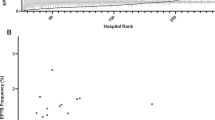Abstract
OBJECTIVE:
To examine the site of delivery for very low birth weight (VLBW) infants and infants with major congenital malformations (MCM) within an established system of perinatal regionalization.
STUDY DESIGN:
A retrospective study of site of delivery for VLBW infants and infants born with MCM (tracheoesophageal fistula/esophageal atresia, diaphragmatic hernia, or gastroschisis/omphalocele) from 1990 through 1995 in Ohio.
RESULTS:
A total of 59.8% of VLBW infants and 36.1% of MCM infants were born in a level III hospital. There was a significant trend toward a decrease in VLBW infants (p < 0.01) and an increase in MCM infants (p < 0.05) born in a level III hospital between 1990 and 1995. There were significant regional variations among the six perinatal regions in Ohio in the proportion of both VLBW and MCM infants born in a tertiary center.
CONCLUSION: Using the traditional marker of VLBW to assess regionalization in one state, we found significant variation in site of delivery among the perinatal regions and over the time course of the study. The delivery of infants with MCM at level III centers may be an alternative measure of regionalization.
Similar content being viewed by others
Author information
Authors and Affiliations
Corresponding author
Rights and permissions
About this article
Cite this article
Mehta, S., Atherton, H., Schoettker, P. et al. Differential Markers for Regionalization. J Perinatol 20, 366–372 (2000). https://doi.org/10.1038/sj.jp.7200391
Published:
Issue Date:
DOI: https://doi.org/10.1038/sj.jp.7200391
- Springer Nature America, Inc.
This article is cited by
-
Hospital Factors and Nontransfer of Small Babies: A Marker of Deregionalized Perinatal Care?
Journal of Perinatology (2004)
-
Local Health Department Perspectives on Linkages Among Birthing Hospitals
Journal of Perinatology (2003)
-
Expansion of Community-Based Perinatal Care in California
Journal of Perinatology (2002)




